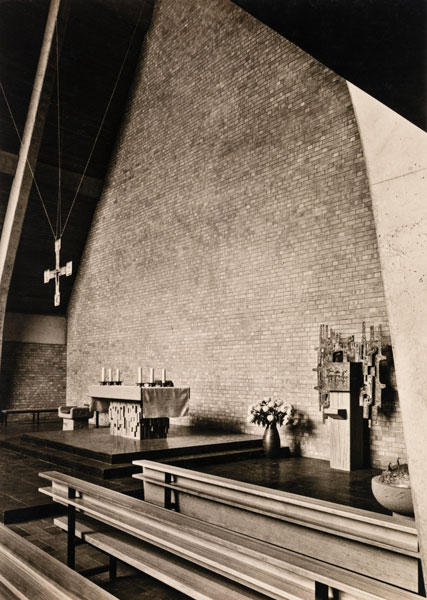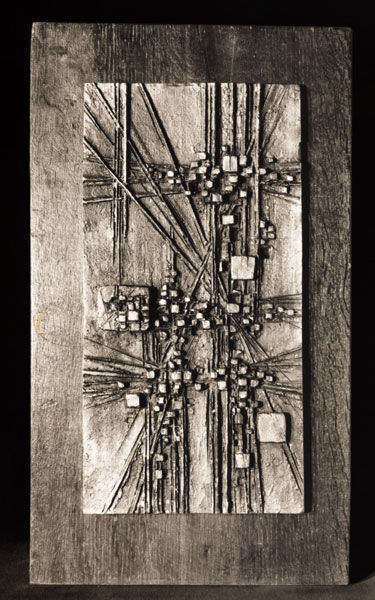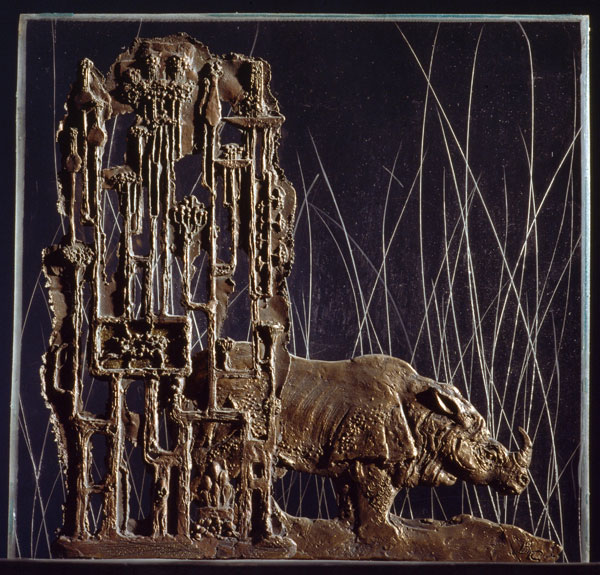Texts
Art as a Purpose and Task in Life
Bernhard Gewers –
Art as a Purpose and Task in Life
By Gerhard Lohmeier
Unobtrusive and modest, regarding his artistic activity as his purpose and task in life, this is how I would like to describe the life of Bernhard Gewers, who would have turned 93 this year, on 27 April 2020. As I was on friendly terms with Bernhard Gewers for many years, I am very grateful that I may add a few remarks on the life and work of Bernhard Gewers on the occasion of the book launch.
Bernhard Gewers has earned great merits as a sculptor and graphic artist, as an architect, as a designer and decorator of church interiors, as a restorer and also as a teacher at the Fachoberschule für Bau und Gestaltung far beyond the borders of the Osnabrück region.
Especially in Hagen/ATW, where he lived with his family since 1963, significant evidence of his multifaceted work can be seen. For example, he created the two altars in St. Martin‘s Church, the ambo, the tabernacle, the baptismal font and the altar cross.
Other works by him are the large marble St. Martin in a niche of the former church in Hagen and the group of crosses in the forest cemetery, the harvest thanksgiving woman in Gellenbeck and the memorial for the pastor Gustav Görsmann, who worked in Gellenbeck and later died in a concentration camp, at the primary school in Gellenbeck.
Bernhard Gewers was also a member of the Bund Bildender Künstler (BBK) in Osnabrück and participated several times in exhibitions of this group in the Kunsthalle Dominikanerkirche. There are also some of his works in the Diözesanmuseum in Osnabrück and in private collections.
I still remember very well my first meeting with Bernhard Gewers in 1983. We, the Verein der Krippenfreunde Osnabrücker Land und Emsland e.V. and I, were planning our second nativity scene exhibition in the Dominikanerkirche in Osnabrück at that time and we were also planning to ask Bernhard Gewers whether he could not also provide us with a nativity scene for our exhibition.
We had arranged to meet at the vocational school in Osnabrück, where he was teaching at the technical college for construction and design at the time. But the meeting went very differently from what I had expected, because after a brief introduction to each other and a description of our project, he went on and on about the nativity scenes in Coesfeld, about old nativity scene figures in his possession and about his ideas on how to make the representation of the birth of Jesus contemporary.
So our first conversation in the entrance to the underground car park lasted more than half an hour without coming to any conclusion. But then he invited me to visit him in his house in Hagen in the near future and then we wanted to talk further about our concern.
And so I went to Hagen a few days later, where he welcomed me to his home and introduced me to his wife Ilse.
I didn‘t yet know what an interesting life Bernhard Gewers had led up to that point, because at that time I thought he had switched to teaching as a sculptor in order to give art lessons to the pupils at the Fachoberschule Gestaltung.
Then, as we sat having coffee, he began to tell me something about his life.
He said that he had deliberately put a lot of time into his education; it had taken him almost 13 years, from 1947 to 1959, to achieve what he had envisioned. He first acquired his practical and theoretical skills through an apprenticeship as a stone and wood sculptor in Münster and subsequent studies at the Werkkunstschule in Münster. He then studied at the Academy of Arts in Stuttgart from 1950-53 and began studying architecture in Darmstadt almost simultaneously, graduating in 1959. While studying, in 1956, he passed the master‘s examination as a stonemason and wood sculptor.
The study of architecture, he said, was very important for his development, in addition to his sculptural training, because it gave him above all the ability to grasp spaces in churches and in public spaces intensively and to understand them better. His idea was to design his artworks in such a way that they merged with the spaces. A high standard, which he also pursued throughout his life. „A work of art without the accompanying space is only half a work of art“, was his concluding opinion.
The fact that Hagen/ATW, of all places, was to become his artistic home was due more to chance than anything else.
At the beginning of the 1960s, he received a large commission from his hometown of Vreden, which, because the block of stone was so large, he executed directly in the quarry near Rheine. On this occasion, the family rented a flat in Rheine at short notice to be closer to the quarry. It was also at this time that the desire arose to find a permanent place to live and to set up a studio. In their search for a suitable place between Münster and Osnabrück, the family also passed through Hagen. Since the place and the landscape met the family‘s expectations, they searched intensively for a place to stay and for a location for the studio. So in 1963 the decision fell on Hagen/ATW, where Bernhard Gewers and his wife finally built a house and also a studio, which from then on was to be the centre of his artistic life.
The profession as an artist was not easy at the beginning, he often found the waiting for a new commission very painful,“ he continued, „but he trusted that things would get better at some point. He used this time of waiting to experiment, to look for new forms of design and new technical solutions.
We hardly talked about Christmas cots on this day either, but rather he spoke about the basic structures of his artistic work, which he attributed to very different influences and experiences.
On the one hand, there was the realisation of the wealth of forms and materials in nature. The variety of forms and materials he found in nature thrilled him and inspired him again and again. „In nature you find the perfect form“, he said referring to his work as a stonemason and as a sculptor, where, even in the most difficult works, he followed the structures of nature present in the material and designed his works.
The other was his completed studies in architecture, which opened up to him a new way of seeing spaces, a special relationship to the world and the universe.
And he also told us that his artistic work was also guided by his basic religious attitude. „He comes,“ he said, „from a Catholic family from the Münsterland and he felt connected to this basic attitude towards faith throughout his life. He said his faith also helped him in the design of choir and church interiors, which he designed in many churches in northern Germany, in the Osnabrück region and in the Ruhr area.“
His altars, candlesticks, lecterns and figures of saints, which he created in sandstone, marble, bronze or aluminium, still reflect the work of a sculptor who lived his faith and made it visible in his works.
His works, as I understood him, were not meant to have an effect on the viewer in isolation, but together with the space. He was also concerned that his works should not be interpreted arbitrarily, but should approach his intention through the encounter in the space.
It took some time before we finally got around to talking about the nativity scenes. At one of these meetings, he fetched a bronze relief from a room that he had just fetched from the foundry. He had mounted it on an old oak board and donated it to the Nativity Society for the exhibition.
It depicted the birth of Jesus in a modern but very convincing form.
„It doesn‘t always have to be plastic figures,“ he said, adding that it was possible to use motifs and design elements other than those that had been handed down without changing the content of the Christmas message. He referred to the ox and donkey lying on top of each other, to Joseph placing his upper body on the neck of the ox and to the star, which he had designed not as a traditional star but from crossing rays.
These crossing rays are found in many of his works, especially in what he calls his „cosmic compositions“.
We also find the crossing rays on the tabernacle door in the new St. Martin‘s Church in Hagen, which he described in this context as „rays of power between heaven and earth“ and which he also wanted to be understood in this way on his nativity relief.
He said that it was his concern, both in his work in the church and in the design of his nativity scenes, „to design sacred places, or pictures or figures depicting scenes from the history of salvation, with due dignity, and the rays of power also serve this purpose.“
He said that it was his concern, both in his work in the church and in the design of his nativity scenes, „to design sacred places, or pictures or figures depicting scenes from the history of salvation, with due dignity, and the rays of power also serve this purpose“.
The crossed rays, which Bernhard Gewers interpreted in conversation as „mediators between the divine and the earthly“, he later also created on two other reliefs with Christmas motifs, which are now also in the possession of the Friends of the Nativity Scene Association.
Bernhard Gewers not only created his works of art from wood, sandstone, bronze or aluminium, in later times he also used concrete. Concrete was not his preferred material, because it was not possible to achieve the fineness and detail that he envisaged. This, he says, always bothered him a lot, but the „clients would have asked him to use this material for cost reasons.“
The two huge stelae in the Warendorf grammar school, the memorial in Bad Bentheim or the concrete sculpture in the schoolyard in Recklinghausen are worth mentioning. But he also said very forcefully, „I am not a concrete artist, other, monitory aspects played a role in these works, which had to be taken into account.“
He also fondly recalled what was probably his greatest work in his home town of Vreden. The block of stone he had to work on was so large that he carried out the work for the memorial that was to become of it in the quarry.
He found it a great pleasure to be commissioned to design the 15-metre-long and almost three-metre-high iron grille for the entrance to Osnabrück Zoo. Here he drew on his love of nature and designed the entire entrance with leaf motifs, each different, but in fullness as a unity.
That Bernhard Gewers specialised mainly in ecclesiastical art was soon apparent when visiting his house in Natrup-Hagen. Paintings, drawings and copperplate engravings and many angels in all sizes and from different eras were on display there, and at Christmas time the large nativity figures, which are now with his son Georg in Berlin, were also set up. He and his wife particularly enjoyed these figures.
The years passed and we met again and again in Hagen or at our home in Osnabrück and our friendly relations deepened more and more.
After he had already participated in several exhibitions with his works, among others also in the Dominican Church in Osnabrück, the community of Hagen dedicated a first larger exhibition to him in 1992 in the former St. Martin‘s Church. This exhibition, which was very well received by the public at the time, gave an exemplary overview of Berhard Gewer‘s work and showed graphics, reliefs and sculptural representations.
When we were planning another exhibition, Bernhard Gewers gave us eight old nativity figures from the early 19th century. We had never seen such old figures in the local area and were very pleased and happy to be able to show them in the Nativity exhibition.
And then something unexpected happened: when I wanted to return the figures to him, he only said very briefly: „The figures now belong to the Nativity Society, he had discussed it with his wife and that was fine.“ We were speechless, because such old figures can only be seen very rarely and especially not in our area.
And he said something else in this context: he was very grateful to the parish of Hagen and the parish of St. Martinus that he had been able to create several works of art for the parish and the church after he had settled in Natrup-Hagen, when it sometimes took a long time until he received another commission from outside.
It is not easy to classify Bernhard Gewers‘ work stylistically. His training as a sculptor and stonemason was largely oriented towards the art of the 1950s and 1960s, while his architectural studies opened up new perspectives that can be seen in his more abstract and linear works, which later changed again to representational depictions. „I am always looking for something new and want to create new forms and motifs,“ he told me, meaning that as an artist he has no final goal but remains a seeker. This also explains why his works up to his death in 2012 do not present themselves as a continuous development, but as selective contemporary art.
I myself owe Bernhard Gewers a great deal, above all as a person, because our conversations extended far beyond art and much of what we discussed also influenced my relationship to nature and the cosmos. I am still very grateful to him for that today.
Finally, I would like to quote a few sentences from Johannes Brand‘s catalogue essay. It says: „The artistic life‘s work of Bernhard Gewers is of such great abundance, versatility and „multi-layeredness“, as he calls it, that it cannot be presented here. The pictorial part of this book may therefore challenge the reader and viewer to also seek the original encounter. Many of the works are still preserved today in their original state in the space between the Dutch border and Berlin and invite us to experience spaces - indoors and outdoors - as the artist intended and designed them.“
Bernhard Gewers was, as I experienced him, a religious man with a high artistic sensibility, whose works were based on Christianity and contained a high degree of craftsmanship, a distinctive artistic design ability and an always accurate design statement in equal measure.
We owe a great deal to Bernhard Gewers; we can see from his works of art that he understood how to make art his purpose in life.
Prof. Dr. Gerhard Lohmeier
Chairman of the Association of Friends of Nativity Scenes
Osnabrücker Land and Emsland e.V.
 |
|
 |
|
 |
|
 |
|
 |
|
 |
|
 |
|
 |
|
 |
|
 |
|
 |
|
 |